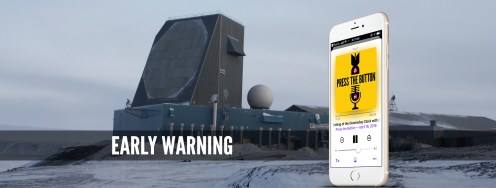Navy Warns of Ship Cuts, Budget Shortfalls Because of Costly Nuclear Subs
On the radar: Subs sinking Navy budgets; Obama sees opportunity with Iran; Missile defense politics are expensive; Myanmar inks protocol; China adds SWUs; and Attracting tourists, apocalypse survivors.
On the radar: Subs sinking Navy budgets; Obama sees opportunity with Iran; Missile defense politics are expensive; Myanmar inks protocol; China adds SWUs; and Attracting tourists, apocalypse survivors.
September 18, 2013 | Edited by Benjamin Loehrke and Alyssa Demus
Boomer budget bulge - The Navy is planning to buy 12 new ballistic missile submarines that are so expensive - with the Navy facing a $60 billion funding shortfall over program - that the Navy would either need to cut ships for its surface fleet or eventually take $4 billion each year from somewhere else in the Pentagon’s budget.
--”The Navy’s funding shortfall — almost two-thirds of the entire acquisition cost of the submarine program — brings into stark contrast two of its core strategic goals: fielding a fleet of at least 306 warships and recapitalizing its nuclear deterrent fleet with the $93 billion Ohio-class replacement program. The price tag is so high on the subs — an estimated $5.4 billion per vessel after the first one — that building them could crowd out funding for other ships the Navy is counting on to reach its overall fleet size target,” writes Frank Oliveri.
--The Navy’s director of the sub program and several lawmakers stress the importance of the new sub fleet and are supportive of finding new money. Critics label the Navy’s appeal to take the subs off-budget as a tactic in the Pentagon’s internal war over shrinking defense budgets. Roll Call has the story. http://bit.ly/18bfOlX
Don’t tell carrier advocates - “The Navy views the Ohio-class replacement ballistic missile submarine as its top priority, indicating it would be prepared to slash other ship programs to build the 12 submarines it needs. Senior congressional aides noted that the Navy would consider reducing its 11-aircraft carrier fleet before it would scale back its plans to replace the Ohio-class ballistic submarine,” writes Oliveri in another Roll Call article. http://bit.ly/1brdUTi
Welcome to Early Warning - Subscribe to our morning email or follow us on twitter.
--Have a tip or feedback for the editor? Email earlywarning@ploughshares.org earlywarning@ploughshares.org. Want to support this work? Click here.
Testing the waters - “There are indications that Rouhani, the new president, is somebody who is looking to open dialogue with the West and with the United States, in a way that we haven't seen in the past. And so we should test it,” said President Obama in an interview with Telemundo. "There is an opportunity here for diplomacy...And I hope the Iranians take advantage of it." Reuters has the quote. http://bit.ly/152JWDe
Opportunity knocking - “Since Hassan Rouhani was elected president of Iran, he and his appointees have piled up indication upon indication, in their words and their actions, that they strongly want a new and improved relationship with the West and that they will do what they can to bring one about by facilitating a mutually acceptable agreement regarding Iran's nuclear program,” writes Paul Pillar in an article outlining the opportunity with engaging Iran on its nuclear program.
--”Only those outside Iran who are determined to subvert the prospect of a better relationship with the Islamic Republic can deny that there now is a major opportunity for achieving one and specifically for settling the nuclear issue in a manner fully protective of U.S. interests,” writes Pillar. Full post at The National Interest. http://bit.ly/1eoXkVq
What color sharpie this time? - “Netanyahu to Focus on Iranian Nuclear Threat at U.N.” by Jodi Rudoren of The New York Times. http://nyti.ms/1a3NDGU
Sites revealed - Last Friday, the Pentagon released five prospective locations for possible U.S. Ground Based Midcourse (GMD) missile defense sites. It is estimated that it would cost $3.6 billion to build and operate a new site over the first five years - a hefty sum considering the existing “system has failed to shoot down test missiles in eight of 16 attempts since 1999, even though operators were given time time and place of ‘the attack’ ahead of time.” Laura Grego at All Things Nuclear has the full story. http://ow.ly/oZ7ME
Tweet - @NTI_GSN: North Korea Calls for Return to Six-Party Talks on Unconditional Basis http://t.co/2vymaFV5YT
Myanmar’s Additional Protocol - Myanmar signed the Additional Protocol to its IAEA safeguards agreement yesterday, allowing the UN nuclear watchdog to have greater oversight and inspection powers with regard to Myanmar’s nuclear activities. http://reut.rs/1eoVKTx
China’s new plant - China has built a new indigenous uranium enrichment plant - adding approximately 10% to its uranium enrichment capacity. Jeffrey Lewis at Arms Control Wonk measures the building, estimates the SWUs and provides background on China’s enrichment capacity. http://bit.ly/152Vgz8
Speed reads:
--“There’s a reason why Western officials are being nice to Moscow now — they want Russia to destroy Syria’s deadly arsenal on its own soil.” Report from Jeffrey Smith at The Center for Public Integrity. http://bit.ly/18yrVxp
--”India's development of ICBMs likely to fuel arms race with China” by Sachin Parashar for The Times of India. http://bit.ly/1gyw2J0
--”U.K. Lib Dems OK Policy for Fewer New Ballistic Subs” from Global Security Newswire. http://bit.ly/1ePQN7d
Events:
--Missile Defense Agency and U.S. Navy test launch two Standard Missile-3 Block IB interceptors at short-range ballistic missile targets. Reagan Ballistic Missile Defense Test Site, Kwajalein Atoll, Marshall Islands, Central Pacific Ocean. Week of September 16.
--”Iran Sanctions: Tool or Hinderance?” Sens. Richard Blumenthal and Dan Coats. September 17, 10:00-11:00 AM @ Capitol Visitor Center. Details here. http://ow.ly/oUzvQ
--Book Discussion of Command and Control: Nuclear Weapons, the Damascus Accident and the Illusion of Safety.” Eric Schlosser. September 19 @1:20-2:45 PM. New America Foundation. http://ow.ly/oUA74
Dessert:
Doomsday stones - In 1979, an anonymous donor erected a 100-ton granite slab, inscribed in eight languages with instructions to guide civilization after in the aftermath of nuclear war. The monument, named the Georgia Guidestones, draws a lot of speculation - mostly about the donor’s identity and whether the stones could be made into a real tourist attraction. Full story from Alan Blinder at The New York Times. http://nyti.ms/1doTxEA


